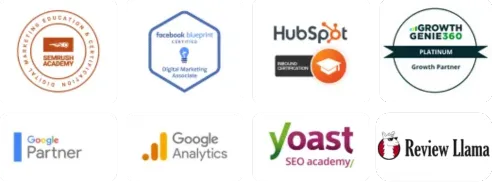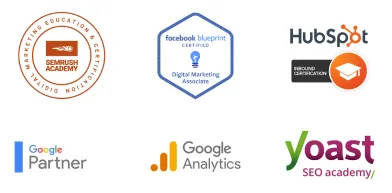TO LEARN IS TO GROW
Learning Center
We do our research and publish our results. Should probably call this the Growing Center.


How to Make Your Images SEO-Friendly
We explain how to make your images SEO-friendly, allowing your website or page to rank higher than your competitors.
Images are not just visual elements to complement the text. While they make the content more understandable to the reader, they also play a critical role in your search engine optimization or SEO strategy.
However, images can also break your SEO efforts. For instance, an image file size that is too big can result in a slow-loading, unresponsive website, which has a detrimental effect on user experience and Google ranking.
Leading SEO and digital marketing expert LOJO Marketing explains the simple hacks to make your images SEO-friendly.
The Image Should Reflect The Content
Your images should complement the content, helping your reader better understand the overall message. Also, make sure that you place them near the relevant text, and position the most important one (the photo that you are trying to rank) near the top of the page–provided that it doesn’t look forced.
Resize The Images
Image size refers to its dimension, e.g., 1280 x 1024 pixels. By contrast, file size pertains to the space needed to store it on the server, e.g., 70 kilobytes.
While images with higher resolutions have a crispier detail, they can slow down the web page loading time. A good rule of thumb is to use the lowest resolution without affecting the user experience or making the website appear like an amateur project.
Pro Tip
Most small web graphics and images can be 300 kb or less. But for e-commerce images, the best practice suggests that it should be below 70 kb since online shoppers are less forgiving when it comes to the loading speed.
If you have the option, always click the “save for web” (Photoshop has this feature) when saving your images; this ensures that your visual elements are stored in a web-friendly resolution.
Choose The Correct File Format That Has A Smaller File Size
A good rule of thumb is to use JPEG for images with lots of colors and PNG for simpler visual elements. Other web-friendly formats include GIF AND SVG, which all use lossless compression, meaning some of the details are lost but not to the point that they result in low-quality images.
Pro Tip
These are the other quick-fix solutions to reduce the file size of web images: Kraken.io, jpeg.io, JPEGmini, ImageOptim, and EXIF data removal.
Warning
Despite the popularity of animated GIFs, they come with two major downsides: they bog down your web page and distract your reader’s attention.
Use Descriptive Alt Texts

Google and other search engines cannot “read” and rank images, graphics, and videos unless you write a descriptive alt text, which is also called alt tags and alt description.
Having a descriptive alt text not just makes your web page SEO-friendly, it also makes it accessible to visually impaired readers using screen-reading tools.
Pro Tip
Be very specific when writing your alt text. For example, a photo of a girl playing basketball should have an alt text that says, “girl playing basketball.”
Other things to keep in mind when writing for an SEO-friendly alt text:
Don’t start with “image of” or “picture of.”
Avoid keyword stuffing.
Every word should have a purpose in describing the image.
Don’t add alt text to decorative images and graphics.
Use Descriptive Captions
Captions are a few lines of text that explain an image. Similar to your alt text, make sure that you are also descriptive and concise with your captions.
Descriptive captions not only allow your content to be “crawlable” and “rankable” by Google bots, but they also help your readers understand your content better. People often use captions to scan the articles, especially those pressed for time.
Warning
Not every image needs a caption. Remember, only add captions when you think they can help your readers–not because you want to be SEO-friendly. After all, website traffic comes from people, not from search engines like Google.
Add images To Your Sitemap
A sitemap is a list of pages within a website (and a domain); its goal is to “tell” the search engines about your site’s content, allowing their bots to crawl, index, and rank you based on your relevance, authority, and other factors.
If you are a WordPress web developer, Yoast offers a sitemap solution.
Pro Tip
Use image extensions for sitemaps to give the search engine giant more information about the images posted on your web pages.
Since May 2021, Google Ads has started allowing all advertisers to use image extension, a feature that was initially available only to select users.
Final Thoughts About How to Make Your Images SEO-Friendly
To recap, SEO-friendly images have these features:
“Supportive” of the content
Reduced image size and file size without affecting the overall quality
Web-friendly formats such as JPEG, PNG, SVG, and GIF
Descriptive alt text
Descriptive caption (only when necessary)
Inclusion on the sitemap
Once you have optimized your images, use tools like Google PageSpeed Insights, WebPageTest.org, Pingdom, or Lighthouse. Remember, studies show that most users expect a loading time of less than 2 seconds, although the ideal goal is to make it under a half-second.
To learn more about making SEO-friendly images and content, contact LOJO Marketing at (916) 303-4080. We are a team of web developers, SEO and digital marketing specialists, and content creators focused on helping small- and medium-sized companies and solo entrepreneurs grow their businesses through online platforms.
Built for Growth. Backed by 25 Years of Trust.
For over two decades, LOJO has been a trusted partner to hundreds of businesses just like yours. Whether working directly with owners, managers, teams, or boards of directors, our goal remains the same: to be a reliable and results-driven asset to your business.
Over the years, we’ve carefully built a team of experts—each selected for their unique skills, strengths, and personalities. Our clients choose LOJO because they know we genuinely care about their success.
And after 25 years of helping businesses grow, we’re more committed than ever.


Built for Growth. Backed by 25 Years of Trust.
For over two decades, LOJO has been a trusted partner to hundreds of businesses just like yours. Whether working directly with owners, managers, teams, or boards of directors, our goal remains the same: to be a reliable and results-driven asset to your business.
Over the years, we’ve carefully built a team of experts—each selected for their unique skills, strengths, and personalities. Our clients choose LOJO because they know we genuinely care about their success.
And after 25 years of helping businesses grow, we’re more committed than ever.




Matthew Rogers, President
iProspect Check
After spending several months reviewing multiple proposals from several different companies we engaged LOJO to develop a new website that represents our company effectively. We worked initially with Stephen Platte who helped create the scope of the project. Stephen was knowledgeable and always followed up with me on time and as promised.
He "closed the deal" for LOJO with his professionalism, service orientation and easy going approach. Once we signed the contract we were introduced to Jay Kelly who would be the creative lead for LOJO. This was the most challenging part of the project for my company, as there was no shortage of ideas from our side. Jay managed the project flawlessly, and once we had all agreed to the design, Jay introduced us to Eric.
Eric Lay is one of the founders of LOJO. Eric took the design we had developed and brought it to life. We delivered content as quickly as he requested it. Eric kept the project on task and we responded by exceeding every deadline for content. In turn, once provided, literally not a day went by that Eric didn't add the content and take the next step. In just a few weeks we launched our new website. Eric is a pleasure to work with.
His positive attitude and consultative approach really enhanced the experience and made a big difference for us in the outcome of our project. We would welcome you to visit our website to take a look at the quality work of LOJO. We are very pleased with LOJO and look forward to working with them in the future as we pursue an aggressive SEO strategy."
After spending several months reviewing multiple proposals from several different companies we engaged LOJO to develop a new website that represents our company effectively. We worked initially with Stephen Platte who helped create the scope of the project. Stephen was knowledgeable and always followed up with me on time and as promised.
He "closed the deal" for LOJO with his professionalism, service orientation and easy going approach. Once we signed the contract we were introduced to Jay Kelly who would be the creative lead for LOJO. This was the most challenging part of the project for my company, as there was no shortage of ideas from our side. Jay managed the project flawlessly, and once we had all agreed to the design, Jay introduced us to Eric.
Eric Lay is one of the founders of LOJO. Eric took the design we had developed and brought it to life. We delivered content as quickly as he requested it. Eric kept the project on task and we responded by exceeding every deadline for content. In turn, once provided, literally not a day went by that Eric didn't add the content and take the next step. In just a few weeks we launched our new website. Eric is a pleasure to work with.
His positive attitude and consultative approach really enhanced the experience and made a big difference for us in the outcome of our project. We would welcome you to visit our website to take a look at the quality work of LOJO. We are very pleased with LOJO and look forward to working with them in the future as we pursue an aggressive SEO strategy."

Matthew Rogers, President
iProspect Check
The team at LOJO were wonderful to work with. They are well organized and very patient as we worked through our marketing strategy and developed a well thought out and clear action plan at a reasonable price. We will definitely be back for our future campaign needs."

Jon Crosby, Founder
Dazil

